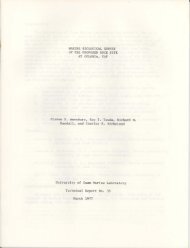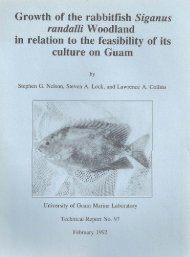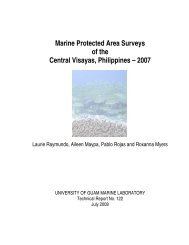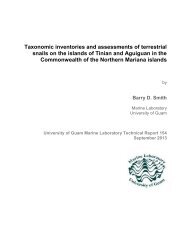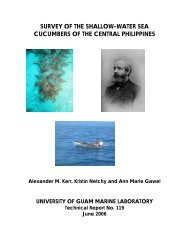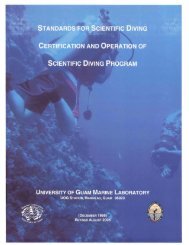Phylogeny of Holothuroidea (Echinodermata) inferred from ...
Phylogeny of Holothuroidea (Echinodermata) inferred from ...
Phylogeny of Holothuroidea (Echinodermata) inferred from ...
You also want an ePaper? Increase the reach of your titles
YUMPU automatically turns print PDFs into web optimized ePapers that Google loves.
PHYLOGENY OF SEA CUCUMBERS 79<br />
support via number <strong>of</strong> unambiguous synapomorphies Mertensio in orbis terrarum circumnavigatione ob-<br />
and bootstrap percentages for branches leading to servatorum. Petropoli.<br />
these clades is not likely to be an artefact <strong>of</strong> character Bronn HG. 1860. Die Klassen und Ordnungen der Strah-<br />
choice, but a reflection <strong>of</strong> history. This in turn suggests lenthiere (Actinozoa), wissenschlaftliche dargestellt in<br />
that these internal branches will prove equally difficult Wort und Bild. In: Bronn HG, ed. Bronn’s Klassen und<br />
to resolve using molecular methods.<br />
Ordnungen des Thier-Reiches, Volume II. Leipzig, 403–404.<br />
The Triassic radiation comprises a clade <strong>of</strong> ho- Cherbonnier G. 1988. Echinodermes: Holothurides. Institut<br />
lothuroids diagnosable in part by a gain <strong>of</strong> table ossen<br />
Coopération: Faune de Madagascar 70: 1–292.<br />
Français de Recherche Scientifique pour le Développement<br />
icles. This group apparently diverged <strong>from</strong> the<br />
Clark HL. 1898. Synapta vivipara: a contribution to the<br />
ancestors <strong>of</strong> Elasipodida by the Middle Devonian (Fig.<br />
morphology <strong>of</strong> echinoderms. Memoirs <strong>of</strong> the Boston Society<br />
5). Fossil table ossicles (parafamily Priscopedatidae)<br />
<strong>of</strong> Natural History 5: 53–88, pl. 11–15.<br />
occurring between this time and the Triassic and as-<br />
Clark HL. 1907. The apodous holothurians. Smithsonian<br />
signed to Dendrochirotida and Dactylochirotida (e.g.<br />
Contributions to Knowledge 35: 1–231.<br />
Clavallus spicaudina; Gutschick & Grill, 1967) prob-<br />
Cuénot L. 1891. Études morphologiques sur les échably<br />
represent stem members <strong>of</strong> this clade. If Dendro- inodermes. Archives de Biologie 11: 313–680, pl. 24–31.<br />
chirotida and Dactylochirotida do have a Triassic David B, Mooi R. 1998. Major events in the evolution <strong>of</strong><br />
origin, as indicated by this study, then very early echinoderms viewed by the light <strong>of</strong> embryology. In: Mooi<br />
records <strong>of</strong> these groups based on simple plate ossicles R, Telford M, eds. Echinoderms: San Francisco. Rotterdam:<br />
are also incorrect. Possibly, the plates indicate a Balkema, 21–28.<br />
Palaeozoic divergence by stem members <strong>of</strong> the Triassic Deflandre-Rigaud M. 1946. Sur les divers types de<br />
radiation. Alternatively, and if they are <strong>of</strong> holothuroid sclérites d’holothurides Oxfordiens des marnes de Villersur-Mer.<br />
origin at all (e.g. Eocaudina; Reich, 1999), the ossicles<br />
Comptes rendus de l’Académie des Sciences 223:<br />
are <strong>from</strong> more distantly related forms, suggesting that 513–515.<br />
imbricate plates and a testaceous morphology have Ekman S. 1926. Systematisch-phylogenetische Studien über<br />
evolved and were lost several times in <strong>Holothuroidea</strong>. Elasipoden und Aspidochiroten. Zoologische Jahrbücher<br />
(Anatomie und Ontogenie der Tiere) 47: 429–540.<br />
Fell HB. 1965. The early evolution <strong>of</strong> the Echinozoa. Breviora<br />
ACKNOWLEDGEMENTS 219: 1–17.<br />
Fell HB, Moore RC. 1966. Echinozoans. In: Moore RC, ed.<br />
We thank many people for their help. L. Buss, C. Treatise on Invertebrate Paleontology, Part U, Ech-<br />
Massin and D. Pawson reviewed an earlier draft. Dis- inodermata 3. Volume 1. Lawrence, Kansas: Geological<br />
cussions with J. Gauthier, R. Mooi, A. Smith and F. Society <strong>of</strong> America and University <strong>of</strong> Kansas Press, U108–<br />
Rowe clarified some important ideas. C. Ahearn, F. U118.<br />
Collier, L. Jarecki, P. Lambert, C. Massin, J. Moore, Ferrigno KF. 1970. Holothurian ossicles <strong>from</strong> the Dundee<br />
G. Paulay, T. White and R. Woollacott provided lab Limestone in southwestern Ontario. Compass 47: 81–93.<br />
space, specimens or hard-to-find literature. J. Kreychossicles.<br />
Frizzell D, Exline H. 1955. Monograph <strong>of</strong> fossil holothurian<br />
man and V. Alexandroba translated Russian. Funding<br />
Bulletin <strong>of</strong> the Missouri University School <strong>of</strong> Met-<br />
came <strong>from</strong> an Ernst Mayr Grant (Museum <strong>of</strong> Com- allurgy and Mines, Technical Series 89: 1–204.<br />
parative Zoology), Lerner Gray Fund (American Mu- Frizzell D, Exline H. 1966. <strong>Holothuroidea</strong>-fossil record. In:<br />
seum <strong>of</strong> Natural History), Falconwood Corporation, Moore RC, ed. Treatise on Invertebrate Paleontology, Part<br />
Sigma Xi, John F. Enders Fund (Yale University), U, <strong>Echinodermata</strong>, Volume 2. Lawrence, Kansas: Geological<br />
US Environmental Protection Agency and Women’s Society <strong>of</strong> America and University <strong>of</strong> Kansas Press, U646–<br />
Seamen’s Friend Society <strong>of</strong> Connecticut.<br />
U672.<br />
Gage JD, Billett DSM. 1986. The family Myriotrochidae<br />
Théel (<strong>Echinodermata</strong>: <strong>Holothuroidea</strong>) in the deep northeast<br />
REFERENCES<br />
Atlantic Ocean. Zoological Journal <strong>of</strong> the Linnean<br />
Society 88: 229–276.<br />
Belyaev GM. 1972. Hadal Bottom Fauna <strong>of</strong> the World Ocean. Gebruk AV. 1990. [On the finding <strong>of</strong> pelagic larvae <strong>of</strong> El-<br />
Jerusalem: Israel Program for Scientific Translations.<br />
asipoda (<strong>Holothuroidea</strong>)] (in Russian with English sum-<br />
Billett DSM, Hansen B, Huggett QJ. 1985. Pelagic Ho- mary). Zoologicheskii Zhurnal 69: 150–152.<br />
lothurioidea <strong>of</strong> the northeast Atlantic. In: Keegan BF, Gebruk AV, Tyler PA, Billett DSM. 1997. Pelagic juveniles<br />
O’Conner BDS, eds. <strong>Echinodermata</strong>. Proceedings <strong>of</strong> the <strong>of</strong> the deep-sea elasipodid holothurians: new records and<br />
Fifth International Echinoderm Conference. Rotterdam: review. Ophelia 46: 153–164.<br />
Balkema, 399–411.<br />
Gerould JH. 1896. The anatomy and histology <strong>of</strong> Caudina<br />
Bonnet A. 1924. Recherches sur l’appareil digestif et ab- arenata Gould. Bulletin <strong>of</strong> the Museum <strong>of</strong> Comparative<br />
sorbant de quelques échinides réguliers. Annales de l’In- Zoology 29: 123–190.<br />
stitut Océanographique nouvelle série 2: 209–230.<br />
Gilliland P. 1992. Holothurians in the Blue Lias <strong>of</strong> southern<br />
Brandt JF. 1835. Prodromus descriptionis animalium ab H. Britain. Palaeontology 35: 159–210.





